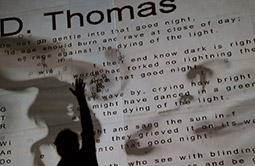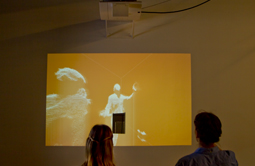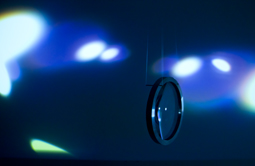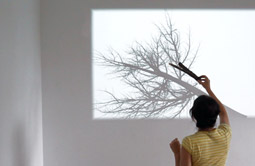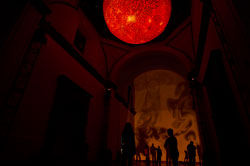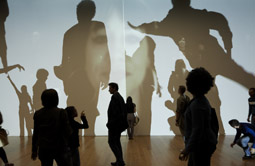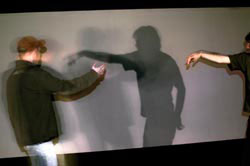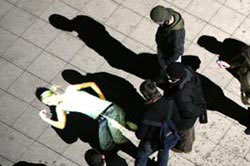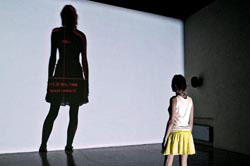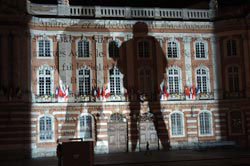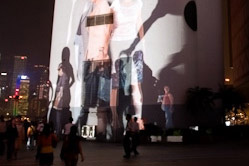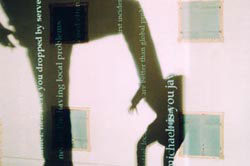Airborne Newscasts
Relational Architecture 20, 2013
"Airborne Newscasts" (Relational Architecture 20) is an interactive installation originally commissioned by the Chrysler Museum of Art to transform Norfolk, Virginia’s public space into a poetic shadow play. By blocking the light of two projectors, participants cast their shadows onto a 900-square-metre wall, and these shadows are tracked by computerized surveillance systems. Out of the shadows emanate billowing smoke which is mapped onto the wall, slowly accumulating within it. Turbulent clouds of live newscasts evaporate from the “heat” of the tracked bodies.
View details.
View details.
First Surface
Shadow Object 3, 2012
“First Surface” (Shadow Object 3) is an artwork consisting of two front surface mirrors that are suspended from a thread and move with the air flow and with a small motor. Projected on the wall behind the mirrors is a real-time virtual representation of the public as seen from the perspective of the mirrors. The public is represented as patterned 3D silhouettes anchored in a reference prism that rotates with the mirrors. The piece is an attempt to construct an artificial perspective on the reflected subject.
View details.
View details.
Semioptics for Spinoza
Shadow Object 4, 2012
“Semioptics for Spinoza” (Shadow Object 4) is a plano-convex lens is suspended from a thread and moves with the airflow and with a small motor. Projected on the wall behind the lens is a set of artificial lens flares generated by equations that take into account the orientation of the lens in relation to the viewing public. The project generates fake light beams that go through the real lens: the lens then diffracts and scatters the fake light creating light source aberrations, directional haze and chromatic distortion.
View details.
View details.
Bifurcation
Shadow Object 2, 2012
“ Bifurcation” (Shadow Object 2) is small Y-shaped branch, similar to a divining rod, which is suspended from a thread and moves with the air flow and with a small motor. Projected on the wall behind the branch is its shadow, only you can see the entire tree from where the branch came. The branch and the tree shadow are always oriented in the same way.
View details.
View details.
Nave Solar
2011
“Nave Solar” is an interactive installation featuring a fake Sun that is activated by the pendular motion of the public as they hang from a rope and swing along the nave of a 16th Century catholic inquisition church. Using tracking systems, the installation detects the motion of participants and generates smoke that accumulates on the ceiling of the apse as well as activates the Sun's flares, surface turbulence and sun spots.
View details.
View details.
People on People
2010
“People on People” is an installation designed to displace the public’s image in real-time, creating a platform for embodiment and interpenetration. The piece consists of floor-mounted projectors that cast the shadow of the public onto a wall and another set of hanging projectors which project images inside the shadows.
View details.
View details.
Sustained Coincidence
Subsculpture 8, 2007
"Sustained Coincidence" (Subsculpture 8) is an interactive installation activated by the spatial relationships of visitors within a gallery. The piece consists of a series of incandescent lightbulbs that light up in reaction to the participants’ positions, in such a way that the shadows cast on the opposing wall are always overlapping. The piece is inspired by the phantasmagorias on the one hand and surveillance and digital analysis on the other.
View details.
View details.
Under Scan
Relational Architecture 11, 2005
"Under Scan" (Relational Architecture 11) is a public art installation based on self-representation. Thousands of "video-portraits" taken in Derby, Leicester, Lincoln, Northampton and Nottingham are projected onto the ground; at first, the portraits are not visible because the space is flooded by white light coming from a high-powered projector. As people walk around the area, their shadows are cast on the ground, revealing the video-portraits in short sequences.
View details.
View details.
Frequency and Volume
Relational Architecture 9, 2003
"Frequency and Volume" (Relational Architecture 9) enables participants to tune into and listen to different radio frequencies by using their own bodies. A computerized tracking system detects participants' shadows, which are projected on a wall of the exhibition space. The shadows scan radio waves with their presence and position, while their size controls the volume of the signal. The piece can tune into any frequency between 150 kHz and 1.5 GHz, including air traffic control, FM, AM, short wave, cellular, CB, satellite, wireless telecommunication systems and radio navigation. Up to forty-eight frequencies can be tuned simultaneously and the resulting sound environment forms a composition controlled by people's movements.
View details.
View details.
Two Origins
Relational Architecture 7, 2002
“Two Origins” (Relational Architecture 7) is an intervention in which the emblematic Place du Capitole in Toulouse was transformed by a projection of The Book of Two Origins, a 13th-century heretical manuscript compiling the theological beliefs of the dualist cathars. Once a vibrant community in several regions of Europe, the believers in the two origins of the Universe were virtually annihilated by the brutal crusades that gave birth to the Inquisition and France's expansion. The texts are illegible since they are projected overlapping each other on the same façade from two distant projectors; only when passers-by block one text with their bodies is it possible to read the other text inside their shadow.
View details.
View details.
Body Movies
Relational Architecture 6, 2001
"Body Movies" transforms public space with interactive projections measuring between 400 and 1,800 square metres. Thousands of photographic portraits, previously taken on the streets of the host city, are shown using robotically controlled projectors. However the portraits only appear inside the projected shadows of the passersby, whose silhouettes can measure between two and twenty-five metres depending on how close or far away they are from the powerful light sources positioned on the ground.
View details.
View details.
Re:Positioning Fear
Relational Architecture 3, 1997
"Re:Positioning Fear" (Relational Architecture 3) was a large-scale installation on the Landeszeughaus military arsenal with a "teleabsence" interface of projected shadows of passers-by. Using tracking systems, the shadows were automatically focused and generated sounds. A real-time IRC discussion about the transformation of the concept of "fear" was projected inside the shadows; the chat involved 30 artists and theorists from 17 countries.
View details.
View details.
